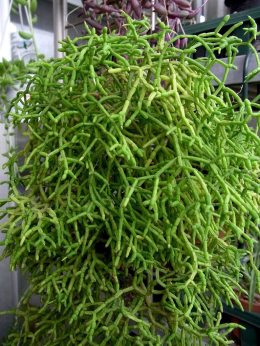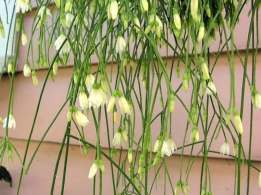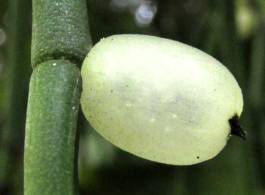
Rhipsalis baccifera, also known as Mistletoe cactus, is a tropical succulent that is native to rainforests in warm climates in subtropical America as well as Africa, Madagascar, and Sri Lanka. It typically grows in the canopy and understory of rainforests often on branches of trees where there is limited sunlight. Unlike most cacti, Mistletoe Cactus requires a moisture rich environment with dim light. It grows long spindly stems up to ten meters in length and have six inch spines. The Mistletoe Cactus is also an epiphyte and gets its water by removing it from the air. There is an unsolved mystery in the botany world as to how the Mistletoe Cactus came to the Americas. All Mistletoe’s relatives are grown and native to Africa and India, at least since botanical record-keeping has begun and it is unknown how the seeds travelled across the Atlantic Ocean and successfully began germinating in the Americas.


https://worldofsucculents.com/rhipsalis-burchellii-mistletoe-cactus/
https://www.backyardnature.net/chiapas/rhipsali.htm
The cactus blooms typically in the first months of the year and produce small, white or cream-colored flowers. After the flower, the cactus produces clear-white berries that are often referred to as “glass beads”. The seeds within the berries are dispersed when birds or small mammals eat the seed contained berries and then secret them in another location, often tree branches. The berries are non-toxic to humans and pets are sweet tasting when ripe, however, there are no known traditional food dishes or medicinal uses of the berries or cactus itself.
Sources:
Giaimo, C. (2017, February 10). The Mystery of the World’s Least American Cactus. Retrieved from https://www.atlasobscura.com/articles/cactus-america-travel-mystery
Neto, H. F. P. (2016). Floral Biology of Rhipsalis paradoxa (Cactaceae: Cactoideae) in Atlantic Mesóflia Semidecidua, Serra do Japi, Jundiai–SP. Journal of Ecosystem & Ecography, 06(04). doi: 10.4172/2157-7625.1000221
The Editors of Encyclopaedia Britannica. (2018, May 8). Rhipsalis. Retrieved from https://www.britannica.com/plant/Rhipsalis
Written by:
Lauren Rogers
